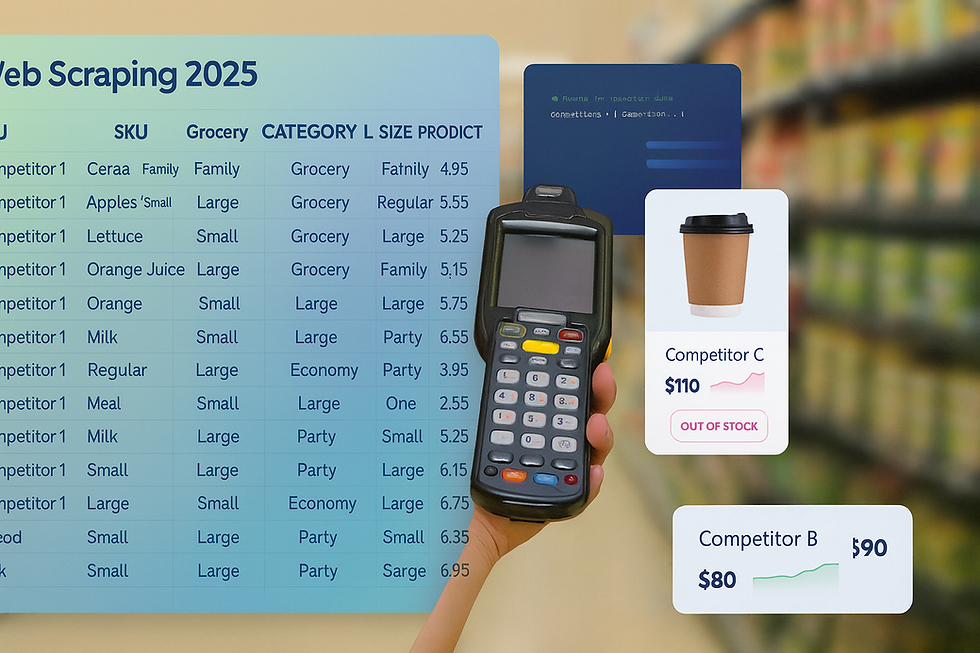Web Scraping Trends for 2026: What Enterprise Leaders Need to Know
- William He

- Aug 21
- 4 min read
Updated: Nov 27

Two decades into building enterprise-grade web scraping data pipelines, I’m still surprised by how quickly the ground shifts under our feet. In the last 12 months, our largest programs have had to absorb price shocks, tariff whiplash, aggressive anti-bot tactics, and a wave of AI both helpful and adversarial. Because Ficstar works with complex, high-stakes initiatives, we feel these forces first. We also get to stress-test what actually works at scale, and under real business deadlines!
This piece is a view from the inside: what my team and I are seeing across our projects, the patterns that matter for 2026, and how leaders can turn volatility into an advantage.
In preparing this article, I spoke with our development and engineering lead, Scott Vahey, who made a great contribution to this topic while I was gathering information to write this article.
What changed in web scraping in 2026
Tariffs moved from backdrop to active variable: Several clients asked us to incorporate live tariff states into their price and margin models. We captured product prices and scraped rule pages, notices, and HS-code guidance. We linked these to SKU catalogs and shipping lanes. Complex, but it delivers results. We also have clients monitoring tariff status on websites for products with dynamically changing tariffs in the US.
When tariff conditions flip mid-quarter, the companies that see it first and map it to their SKUs win share and protect margin. That requires web automation tuned for policy sources as much as for product pages.
Inflation and uncertainty hardened demand for price monitoring: Companies are more interested in price monitoring with inflation and the uncertainty of the economy. Interest that was once “nice to have” is now board-level.
We responded by standing up real-time crawls across entire categories, not just a handful of competitors capturing prices, promotions, inventory flags, delivery fees, and regional deltas. In some programs we refresh critical SKUs hourly. The volume is massive, but the bigger lift is normalization and QA so the numbers are trusted by Finance and Legal.
AI stepped into quality control, quietly and effectively: We’ve always layered rule-based checks, but this year we expanded model-assisted validation for hard-to-spot defects. We have been implementing more AI into our data quality checking to source out discrete issues. This isn’t AI as a headline; it’s AI as an additional set of eyes that never tires, flags weirdness, and helps our QA team focus on the cases that genuinely matter.
2026: Enterprise web scraping trends I’m betting on
1) The AI cat-and-mouse will accelerate on both sides
Everything about web automation is now co-evolving with AI: bot detection, behavioral fingerprinting, content obfuscation, DOM mutation, and anti-scrape puzzles are being trained and tuned by models. The reciprocal is also true: our crawlers, schedulers, and parsers now lean on models to adapt.
Scott put it this way:
“Blocking and crawling algorithms will continue to play cat and mouse as they will both be powered by AI.”
For enterprise leaders, the implication is governance and resilience, not gimmicks. You need providers who can (1) operate ethically within your legal posture, (2) degrade gracefully when the target changes, and (3) produce an audit trail that explains exactly how data was gathered.
2) Price intelligence will widen beyond “the price”
Uncertain times change consumer behavior. As Scott notes:
“Uncertain times, inflation, bigger gaps in wealth will lead to more emphasis on price for the consumer.”
We’re seeing “price” morph into a composite: base price, fulfillment fees, membership gates, rebate mechanics, personalized offers, and increasingly, time to deliver. In several categories, delivery-time promises are worth as much as a small price cut.
3) AI-assisted analysis will shrink “data-to-decision” time
The big unlock in 2026 won’t be bigger crawls; it will be faster turnarounds from raw web signals to boardroom decisions. Scott’s prediction touches the core:
“Analyzing large datasets will become more effective with AI and make it easier for companies to act on specific strategies.”
We’re already seeing this in our internal programs: model-assisted normalization chops days off integration; clustering and entity-resolution models assemble scattered variants; anomaly detectors surface “pricing events” instead of 10 million rows of deltas. One global auto-parts client used these layers to spot a competitor’s stealth re-pack of kits into higher-margin bundles within 72 hours of rollout.
4) End-to-end managed pipelines will overtake “feeds”
Five years ago, it was common for large firms to ask for a firehose and build the rest themselves. In 2026, the winners will be teams who outsource the undifferentiated heavy lifting, extraction, QA, normalization, enrichment, delivery SLAs, and focus their internal talent on modeling and action.
We see this shift every quarter. For a Fortune-500 CPG client, we moved from weekly CSVs to a managed pipeline with health monitors, model-assisted QA, and direct connections to their feature store and ERP. The result: fewer brittle internal scripts, more time on promotions strategy, and auditable lineage across the stack.
Where I think web scraping goes next
The web will keep shifting. Detection will get smarter. Interfaces will fragment. Regulations will evolve. But the strategy doesn’t change: gather only what you need, gather it the right way, validate it ruthlessly, and connect it to decisions fast!
At Ficstar, that’s the work we lead on our internal programs before we roll it out to clients. If you’re navigating inflation, tariff volatility, or a competitive set that doesn’t sit still, we’d be glad to put those muscles to work for you safely, at scale, and with outcomes you and your team can both trust and rely on.

Comments